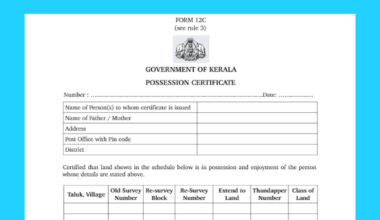Owning a home is a symbol of security and stability, and it is a dream that many people hope to make a reality. However, the increasing costs of real estate have made this goal more challenging to achieve. Therefore, securing a home loan has become a vital step in this pursuit. Essentially, a home or housing loan process entails borrowing a sum of money, typically from banks or other lending institutions. The borrower commits to repaying the loan balance, along with interest, over a period spanning from 10 to 30 years through Equated Monthly Installments (EMIs).
The home loan process involves lots of steps, and navigating through them can be challenging, especially for first-time buyers. Our home loan process step-by-step guide aims to ease your path to homeownership. It offers invaluable insights, helping you comprehend each step involved and manage your expectations effectively.
Home Loan Process: Step-By-Step Guide
Before you apply for a home loan, it’s crucial to plan and do thorough research. Think about important factors like the monthly EMI amount you’ll pay, how long you’ll take to repay the loan, the initial down payment you can afford, and whether you need mortgage insurance. Also, consider any additional fees that the bank may charge. Understanding different loan options, interest rates, and the required documents will help you make better decisions throughout the home loan process.
Let’s now explore each step involved in obtaining a home loan.
Step 1: Assess Your Home Loan Eligibility
The first step in the housing loan procedure is to assess your eligibility for a home loan. This involves evaluating your financial situation, including income, age, co-applicant’s income (if applicable), credit score, and existing debts. Next, calculate your borrowing capacity, which is the maximum amount you can borrow based on income, assets, and debt. Lenders consider factors like your current income, employment history, assets, and existing debt obligations to ascertain this capacity.
Step 2: Choose Your Lender Wisely
In India, you have many options for getting a home loan, such as banks, housing finance companies, and non-banking financial companies (NBFCs). Each lender offers different interest rates, terms, and conditions, home loan processing time. So, it’s essential to compare them carefully.
As you proceed with the housing loan process, consider the following factors while choosing your lender:
- Interest Rate: Look for lower rates to have easier monthly payments.
- Terms: Check the repayment period and prepayment penalties.
- Conditions: Understand the down payment requirements and property appraisal process.
Step 3: Complete the Home Loan Application Form
To proceed with your home loan application, download the form from the bank or financial institution’s website or visit their branch office to obtain it. The application form gathers information about you, like your personal details, work history, income, education, and details about the property you want to buy.
After filling out the application form, submit the necessary documents to verify the provided information. Required documents typically include:
- Identification Verification: Aadhaar Card, PAN Card, Passport, Driving License
- Address Confirmation: Aadhaar Card, Passport, Driving License, Utility Bills (electricity bill, property tax receipt, etc.)
- Age Proof: Birth Certificate, 10th Certificate
- Educational Qualifications: Educational Certificates, Mark Sheets
- Income Verification: Bank Statements, Income Tax Returns, Salary Slips
- Business Documentation (for self-employed applicants): Balance Sheets, Profit & Loss Statements, Business License, Proof of Business Address
- Property Details: Approved Building Plan, Society/Builder’s Consent Letter, Estimate of Construction Cost
Step 4: Pay the Application Processing Fee
After completing the application form, the next step in the housing loan procedure is to pay the processing fee to the bank or lender. The processing fee is a non-refundable charge that the lender asks for to start the home loan process and keep your loan account active. This fee includes managing some confidential paperwork, like Income Tax certificates and post-dated cheques, on an annual basis. Typically, the processing fee ranges from 0.25% to 0.50% of the requested loan amount.
Step 5: Application Form Review and Document Verification
This step is a significant part of the home loan process. The lender will review the paperwork, and if required, they may conduct a face-to-face meeting to authenticate information. This helps them assess the applicant’s ability to repay the loan. Once verified, they will proceed further with the loan approval evaluation.
You should be honest and transparent throughout the entire home loan procedure. Banks conduct thorough evaluations of personal and employment details. One key aspect they consider is your creditworthiness. They collaborate with credit bureaus, specialised agencies that gather financial data from various sources and calculate your credit score.
Step 6: Loan Approval and Sanction Letter
If your application is approved, the bank will send you a sanction letter that specifies the loan amount, interest rate, and other terms and conditions. However, in the unfortunate event of your application being rejected, the bank will inform you of the decision and the reasons behind it.
Here are some of the factors that the bank will consider when approving your loan:
- Your income and employment history
- Your credit score
- Your assets and liabilities
- The property you are buying
Carefully review the sanction letter, sign, and return the acceptance copy to the lender, acknowledging your agreement with the stated terms and conditions.
Step 7: Legal Checks and Technical Inspections
After accepting the offer letter, the next step in the home loan process involves the loan provider evaluating the property you wish to purchase. A qualified expert, such as a civil engineer or architect, will conduct a technical inspection of the property. This will involve assessing the construction stage, quality, layout, and compliance with regulations. For ready-to-move-in properties, additional factors such as maintenance, eligibility, and property value will be considered.
Once the property has been verified, the bank will determine its value to ensure a fair loan sanctioning process. Some banks may charge an additional fee for this estimation. This thorough evaluation by banks ensures the legitimacy and value of the property being financed.
Step 8: Loan Disbursal
Once the bank/lender completes its technical evaluation and the lawyer reviews all your paperwork and begin the home loan disbursement process. You will need to submit original property documents, seller details, property information, and any required NOCs, and provide post-dated checks for the agreed duration. After completing the necessary verification, the lender will prepare the Memorandum of Execution (MOE) that includes the loan documents, which will then be stamped and signed.
After all legal requirements are met and you have signed the home loan agreement, the bank/financial institution will disburse the loan amount. The home loan processing time is typically 1-2 weeks, but it may differ from one lender to another based on factors such as your credit score, your application’s complexity, the type of property being financed.
If your property is completed, you’ll receive the full loan amount. If it’s still under construction, the disbursement may be in stages based on the progress. The home loan disbursement process relies on the specific policies of your lender and the terms agreed upon in the loan agreement.
Also Read: Income Tax Benefits on Home Loans
Conclusion
Take the time to research, calculate eligibility, and choose the right home loan provider, as it can significantly impact your overall home loan experience. By following this detailed home loan process step by step, you can confidently navigate through the home loan procedure. This will increase your chances of obtaining the best possible financing for your dream home.








